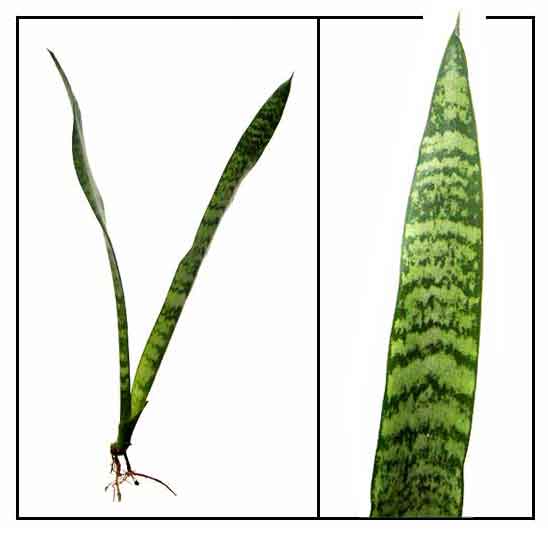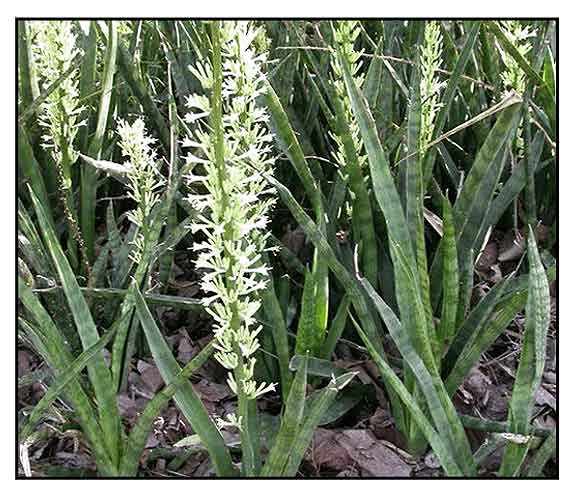
Gen info
- Taxonomy changes: In the sometimes confusing landscape of taxonomy, some plants in the compilation have moved to new families and genera, often with changes in synonyms.
- Sansevieria was once a historically recognized genus of flowering plants. It is now included in the genus Dracaena on the basis of molecular phylogenetic studies. In the APG III classification, Dracaena is placed in the family Asparagaceae, subfamily Nolinoideae (formerly family Ruscaceae). It has also been placed in the former family Dracaenaceae. (19)
- Dracaena is a genus of about 120 species of trees and succulent shrubs.
- The genus name Dracaena is derived from Greek drakaina, meaning "female dragon".
 Botany Botany
Buntot-tigre is a herbaceous perennial with
short stem and a rootstock that is very stout, branching and stoliniferous. Leaves are erect, fleshy, fibrous
and flat ( in other varieties cylindrical or concave above, rounded dorsally),
sub-erect, dagger-shaped, rigid, pale-green with transverse bands of dark
green, or dark-green with gray mottles, 0.4 to 1.5 meters long, 4 to 7 centimeters wide. Scape is erect, 30 to 80 centimeters long. Flowers are pale-colored,
numerous, in fascicles of 3 to 6, sweet-scented, 2.5 to 3 centimeters
long, with the perianth segments nearly twice as long as the tube. Fruit is sparingly produced, globose, about 8 millimeters in diameter. Seeds
are broadly ovoid and white, with horny albumen.
Distribution
- Introduced.
-
Cultivated in many parts
of the Philippines.
- Naturalized, occurring in thickets and hedges at low and medium
altitudes.
- Native to Bangladesh, India.
Constituents
- Contains an active constituent:
the alkaloid sansevierine.
- Phytochemical screening of leaves and rhizomes yielded carbohydrates, saponin, flavonoids, phenols, alkaloid, anthocyanin and ß-cyanin, glycosides, proteins, and phytosterols.
(see study below) (9)
- GC-MS analysis of methanol extract of leaves yielded 16 bioactive phytochemical compounds: diethyl phthalate (1), 6-methyl-1-octanol (2), 2-propyldecan-1-ol (3), 2(4H)-benzofuranone (4), 3,3-dimethylhexanal (5), diisobutyl phthalate (6), 6,10,14-trimethyl-2-pentadecanone (7), 2,5-dimethoxybenzhydrazide (8), 3,4-dimethoxybenzoic anhydride (9), 1,2-benzenedicarboxylic acid, bis(2-ethylhexl) ester (10), dodecanoic acid (11), palmitaldehyde, diallyl acetal (12), 1-butyl 2-(8-methylnonyl) phthalate (13), delta-undecalactone (14), methyl hexadecanoate (15), n-hexadecanoic acid (16). (see study below) (15)
- Study of carbon tetrachloride soluble fraction of a methanol
fraction of whole plant yielded a homoisoflavonoid (cambodianol), and a triterpene (lupeol). (17)
Properties
- Emollient, purgative, tonic, febrifuge, cardiotonic, expectorant.
- Studies suggest antibacterial, antitumor, antidiabetic, antioxidant, cytotoxic, phytoremediative, nephroprotective, cardioprotective properties.
Parts used a
Leaves, stems, shoots, rootstocks.
Uses
Folkloric
- The roasted leaves used as an emollient.
- In India, rootstocks used for cough; tender roots and rhizome used as expectorant. Also used as febrifuge, tonic, purgative, and for bone setting.
-
In India, stem part of rhizome used for toothache. Rhizomes used for consumptive complaints, cough, common cold, and ear pain. (10) Leaves used to treat pimples and skin diseases. (12) Leaves used to treat asthma. (16) Juice boiled with coconut oil applied to ear ache.
- In Bangladesh, juice of tender shoots used in children to clear sticky phlegm from the throat; juice from young leaves applied topically to ear infections.
Ethnoveterinary
- In viral diseases associated with stringy nasal discharge, slightly warmed leaf juice is used as nasal drops, thrice in two hours. A paste is also applied over the body.
- In India, stem part of rhizome used to heal wounds in animals. (10)
Others
- Fiber: The leaves are a source of a
strong white fiber use in the manufacture of bowstring, twine, cloth,
and paper. It is sometimes mixed with the local piña. (see study below 22)
Studies
• Anticancer: Study of the methanol extract of Sansevieria roxburghiana in male Swiss albino mice transplanted with Ehrlich Ascites Carcinoma cell line showed significant dose-dependent anticancer activity. (3)
• Anticancer / Rhizome: Study of hydroalcoholic extract of SR for antitumor activity against EA carcinoma exhibited remarkable antitumor activity attributed to its augmentation of endogenous antioxidant mechanisms. (5)
• Antidiabetic / Antioxidant Modulation: Study of hydroalcoholic extract of SR rhizome in streptozotocin-induced diabetic rats demonstrated remarkable antidiabetic activity possibly through its modulation of endogenous antioxidant status. (7)
• Antimicrobial / Leaves and Rhizome: Study evaluated various solvent and aqueous extracts of leaves and rhizomes of S. roxburghiana against clinically significant bacterial and fungal strains. Methanol and acetone extracts of leaves and ethyl acetate extract of rhizomes showed significant antimicrobial activity against Gram negative and positive bacteria and fungal strains. The leaf extract showed better antimicrobial activity than rhizomes. (see constituents above) (9)
• Antibacterial / Rhizome: Study of ethanolic extracts of rhizome of S. roxburghiana showed antibacterial against gram negative bacteria such as Salmonella typhi, Pseudomonas fluorescens, P. aeruginosa, and E. coli. (10)
• Antibacterial / Leaves : Study investigated the antibacterial activity of pure fractions of leaves of Sansevieria roxburghiana. Two out of three fractions showed pronounced activity at 1 mg/ml against gram positive and gram negative bacteria responsible for various infections. (see constituents above) (15)
• Analgesic / Cytotoxic / Antioxidant: Study of evaluated crude methanolic extract of whole plant of S. roxburghiana for analgesic, cytotoxic, and antioxidant activities. Results showed analgesic activity by acetic acid induced writhing test in mice, cytotoxic activity by brine shrimp lethality bioassay, and antioxidant effect by DPPH free radical scavenging assay. (11)
• Cardioprotective / Cytotoxic / Antioxidant: Study of evaluated the cardioprotective mechanism as well as in vivo potential of methanol extracts of Marsdenia tenacissima and Sansevieria roxburghiana on rats using in silico methods. Dresgenin from MT and lupeol from SR were taken as ligands for the target peroxisome proliferator activated receptors (PPARα) protein to find out the mechanism of action. The combination that showed most significant (p<0.001) effect on altered enzymes and antioxidant enzyme levels in both blood and tissues also corrected the extreme damage in cellular functional units. Results suggest the combination of MESR and MEMT and MEMT exerted cardioprotective activity via binding of dresgenin and lupeol to PPRAα. The order of efficacy was the extract combination > MESR > MEMT. (20)
• Protocatechuic Acid / Suppression of Diabetic Cardiomyopathy / Rhizomes: Study evaluated the therapeutic potential of protocatechuic acid isolated from Sansevieria roxburghiana rhizomes against diabetic cardiomyopathy (DC) using a rodent model of type 2 diabetes (T2D) induced by high fat diet + low-single dose of streptozotocin. T2D rats exhibited high fasting glucose and hyperlipidemia. Significantly (p<0.01) high levels of serum C-reactive protein and pro-infammatory mediators revealed the establishment of inflammatory occurrence. Significantly high levels of troponins in the sera revealed establishment of cardiac dysfunctions in T2D rats. Protocatechuic acid (50 and 100 mg/kg p.o.) treatment could significantly reverse the changes in serum biochemical parameters related to cardiac dysfunctions. It can also significantly (p<0.05-0.01) stimulate glucose metabolism in skeletal muscle, regulate glycemic and lipid status, reduce secretion of pro-inflammatory cytokines and restore myocardial physiology in T2D rats to near normalcy. Results suggest potential for protocatechuic acid to be a new therapeutic agent for diabetic cardiomyopathy in the future. (21)
• Potential as Suture Material for Intraoral Incision: There are references of Murva (Sansevieria roxburghiana) in "Sushruta Samhita" where it was used as suture material. Study evaluated the efficacy of Murva fibers as a suturing material in closure of intraoral incision in third molar surgeries. Patients were evaluated for pain, swelling, bleeding, infection, wound dehiscence, local tissue irritation, and bacterial colonization. Results showed the use of Murva as suture material proved to be effective in closure of intraoral incisions. (22)
• Silver Nanoparticles / Antibacterial: Study reports on the synthesis of silver nanoparticles using leaves of Sansevieria roxburghiana as reducing agents. The NPs showed effective inhibition of human pathogens, including Bacillus subtiilis and Escherichia coli. Results suggest potential for formulation of value-added herbal-based nano-materials in biomedical and nanotechnology industries. (23)
• Gold Nanoparticles / Catalytic Degradation of Toxic Organic Pollutants: Study reports on the synthesis of biogenic gold nanoparticles using Sansevieria roxburghiana leaf extract and their catalytic potential in the degradation of organic pollutants such as 4-nitrophenol, acridine orange, congo red, bromothymol blue, phenol red and methylene blue. (24)
• Nephroprotective / Gentamicin Toxicity: Study evaluated the nephroprotective effect of crude methanolic extract of S. roxburghiana on gentamicin induced renal toxicity in Wistar albino rats. MESR treated groups showed evident nephroprotective effect as seen in reduction of BUN and serum creatinine levels. Lower dose of MESR (250 mg/kbw) significantly reduced levels of serum creatinine (0.3200) and BUN (14.006) to near normal levels. Histological analysis also showed reduced damage compared to gentamicin group. (25)
• Potential of Leaf Cellulosic Fibers as Polymer Reinforcements / Leaves: Study evaluated and characterized the cellulosic fibers from S. roxburghiana leaves for potential as polymer reinforcements. Fourier Transform Infrared Spectroscopy and chemical composition tests confirmed the presence of cellulose (78.63wt%), lignin (9.86wt%), and hemicellulose (2.01wt%), ) along with wax (0.16wt%), ash (1.49wt%), and wetness content (7.85wt%). Tensile strength, percent elongation, and Young's modulus of the fiber was 213.6 MPa, 1.12%, and 16.02GPa, respectively. Results showed the fibers to possess excellent physical, chemical, and surface morphological features to ratify them as potential polymeric reinforcing agents in making biocomposites. (26)
Availability
- Cultivated and wild-crafted. |


![]()

